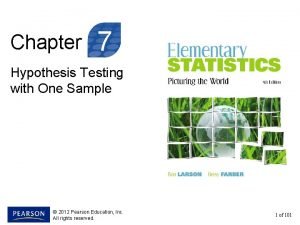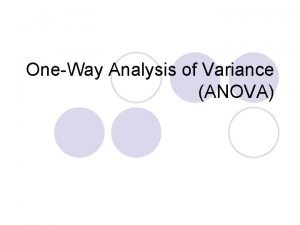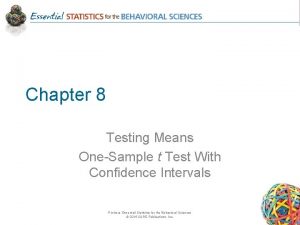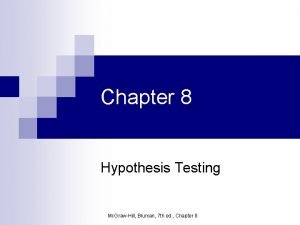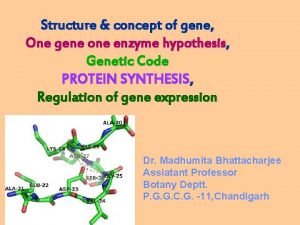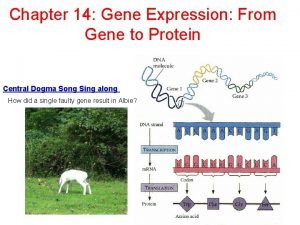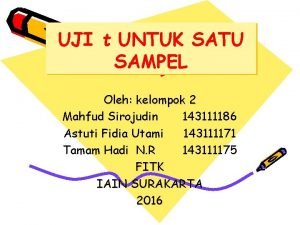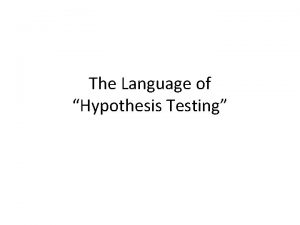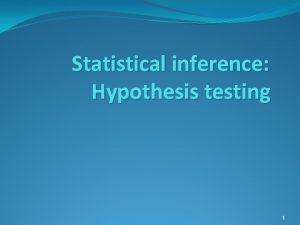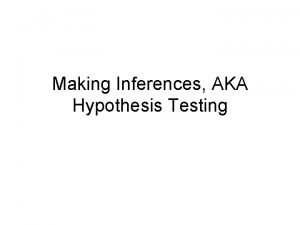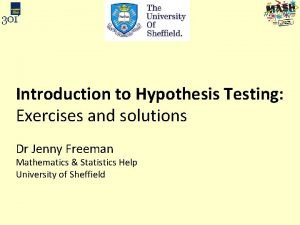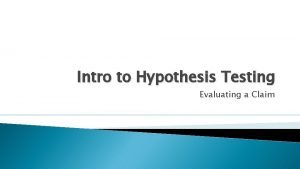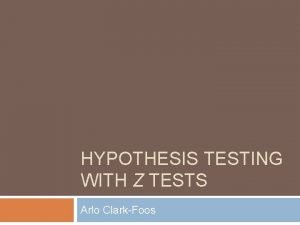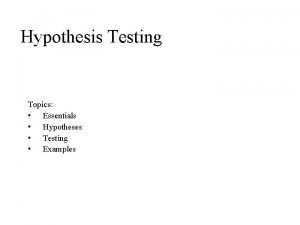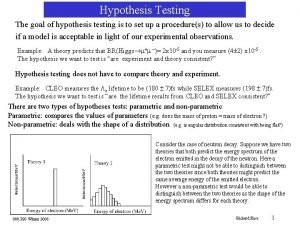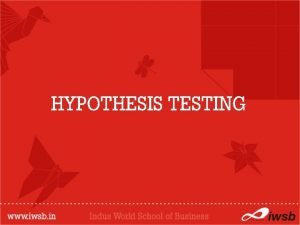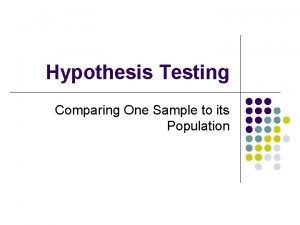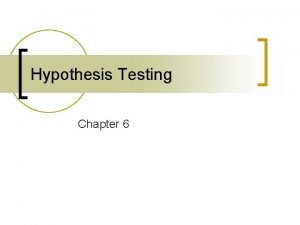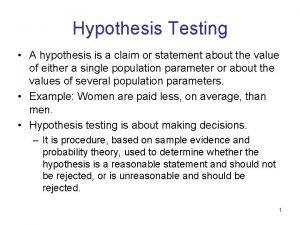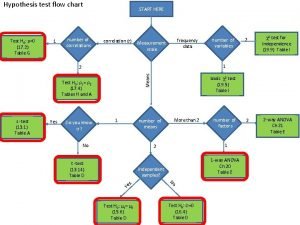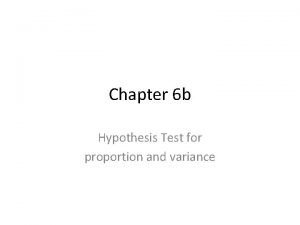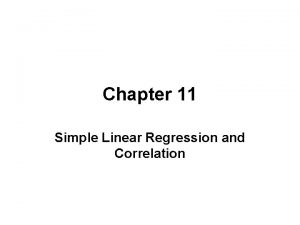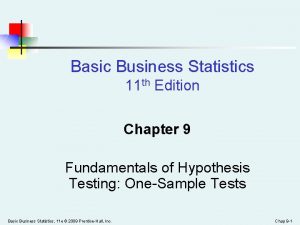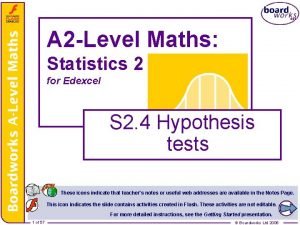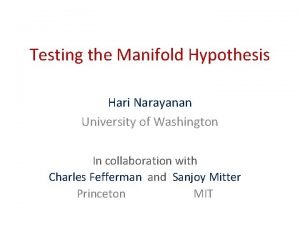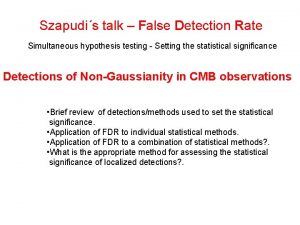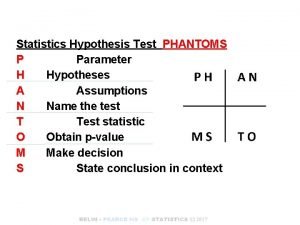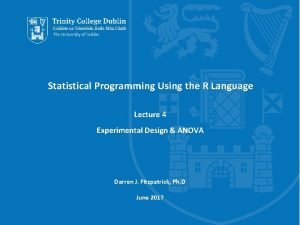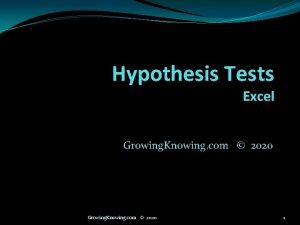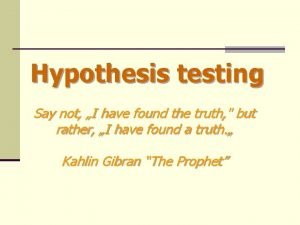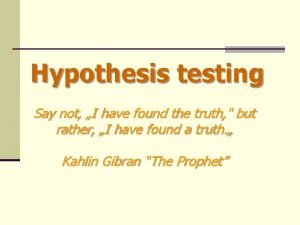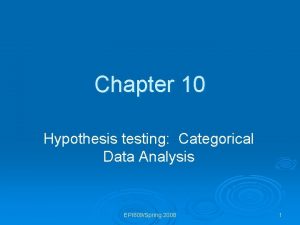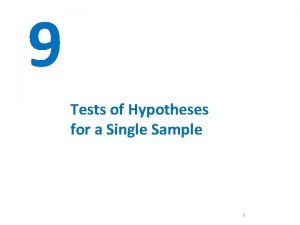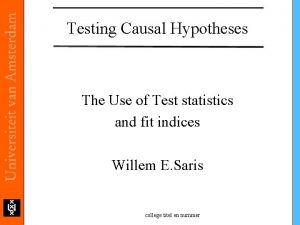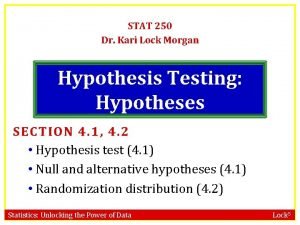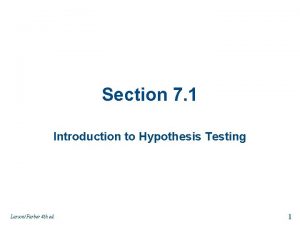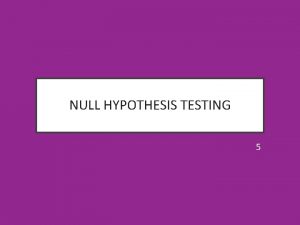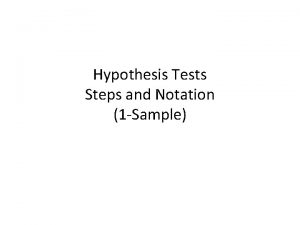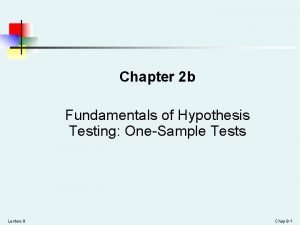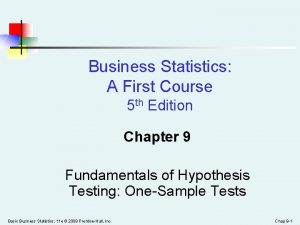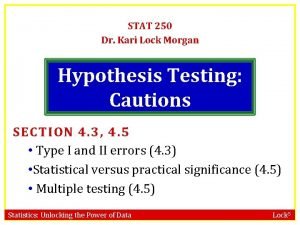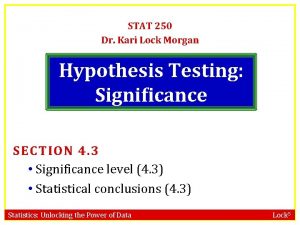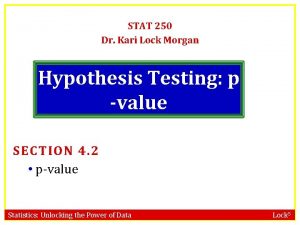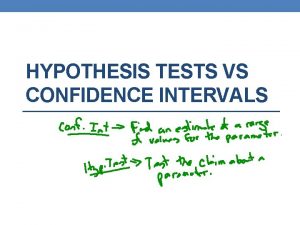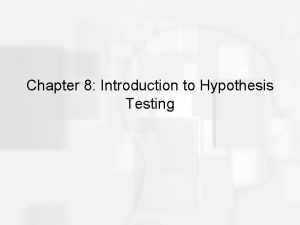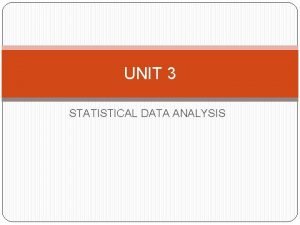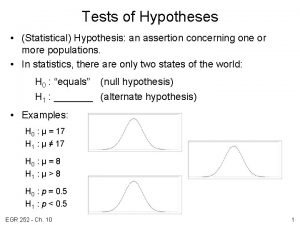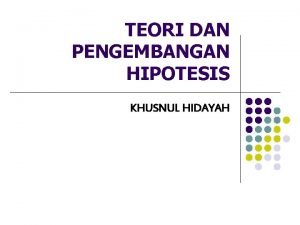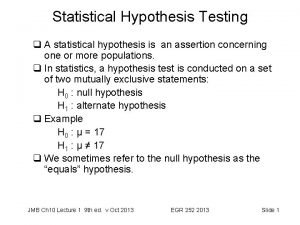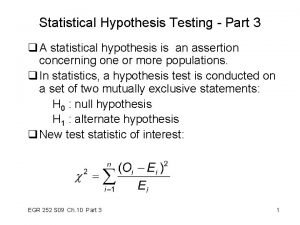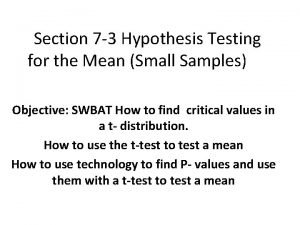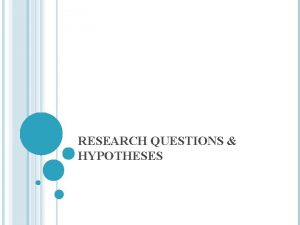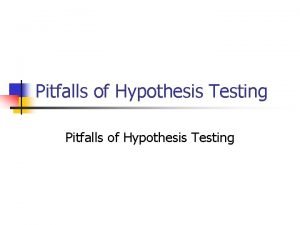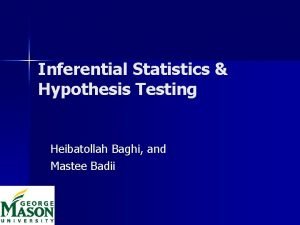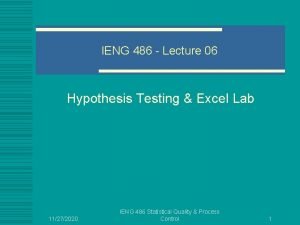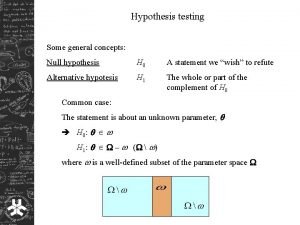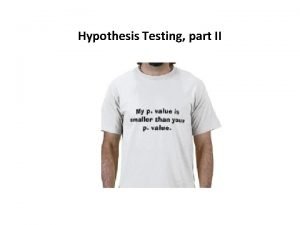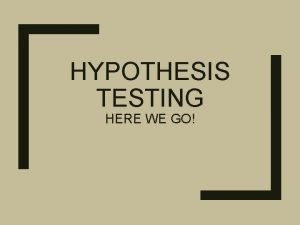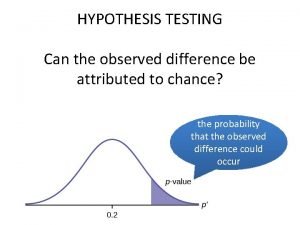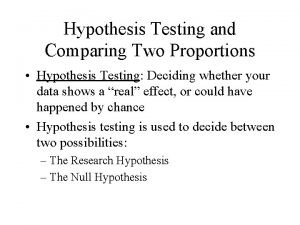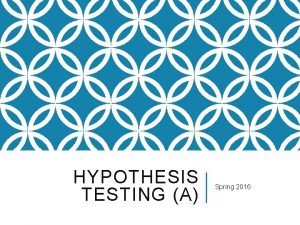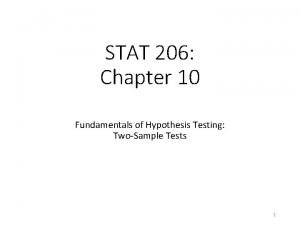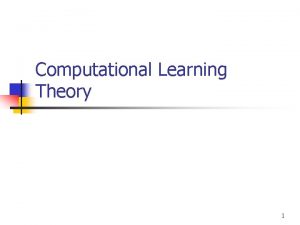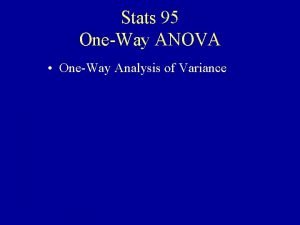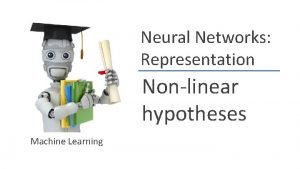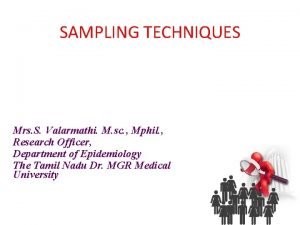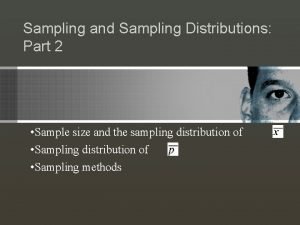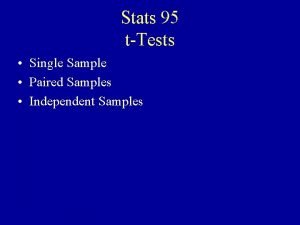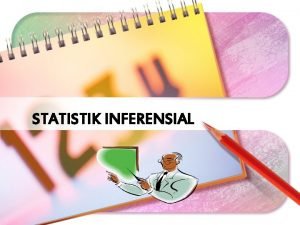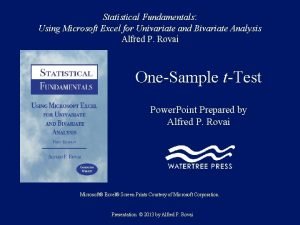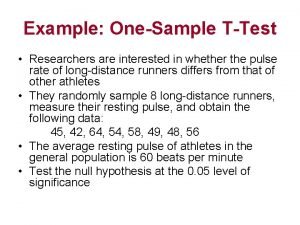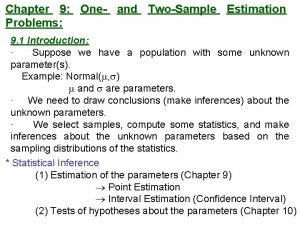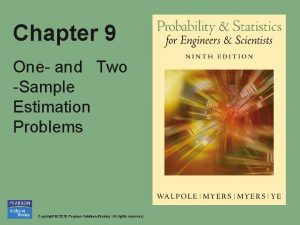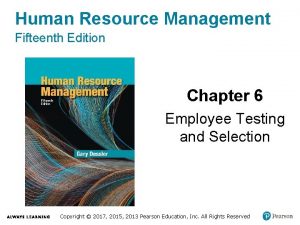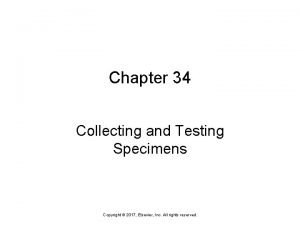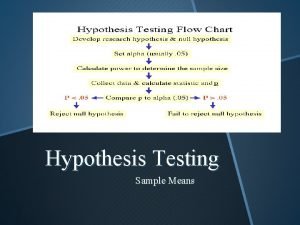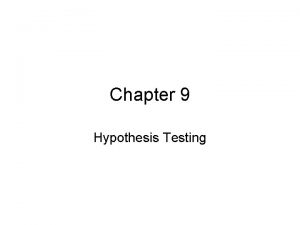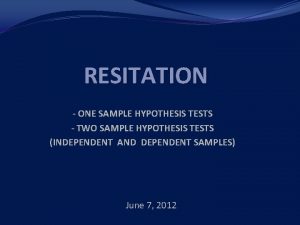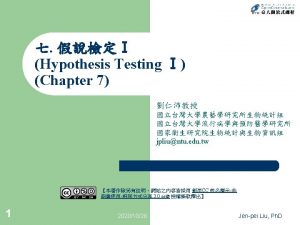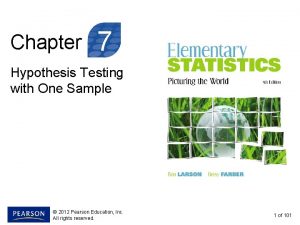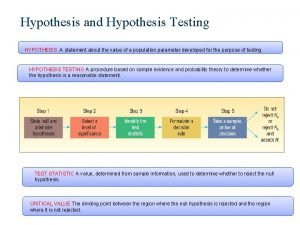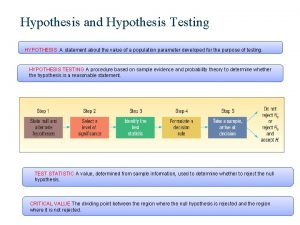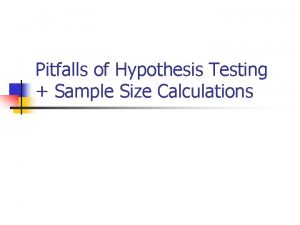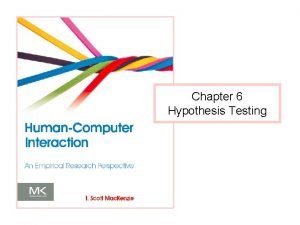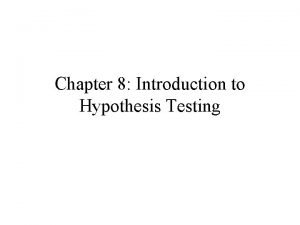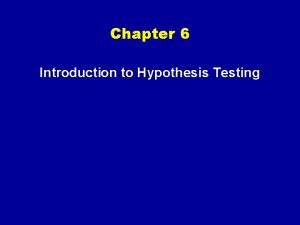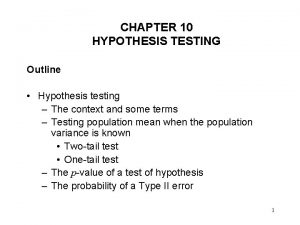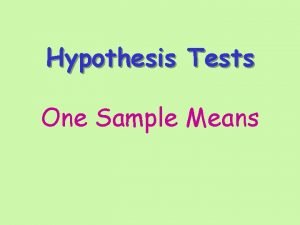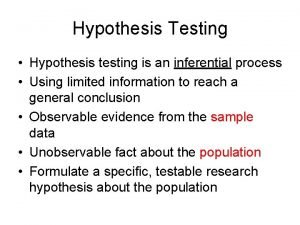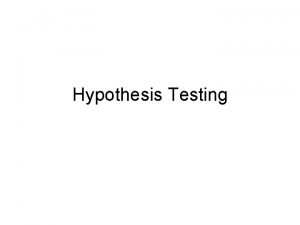Chapter 7 Hypothesis Testing with One Sample 2012























































































































- Slides: 119

Chapter 7 Hypothesis Testing with One Sample © 2012 Pearson Education, Inc. All rights reserved. 1 of 101

Chapter Outline • • • 7. 1 Introduction to Hypothesis Testing 7. 2 Hypothesis Testing for the Mean (Large Samples) 7. 3 Hypothesis Testing for the Mean (Small Samples) 7. 4 Hypothesis Testing for Proportions 7. 5 Hypothesis Testing for Variance and Standard Deviation © 2012 Pearson Education, Inc. All rights reserved. 2 of 101

Section 7. 1 Introduction to Hypothesis Testing © 2012 Pearson Education, Inc. All rights reserved. 3 of 101

Section 7. 1 Objectives • State a null hypothesis and an alternative hypothesis • Identify type I and type II errors and interpret the level of significance • Determine whether to use a one-tailed or two-tailed statistical test and find a p-value • Make and interpret a decision based on the results of a statistical test • Write a claim for a hypothesis test © 2012 Pearson Education, Inc. All rights reserved. 4 of 101

Hypothesis Tests Hypothesis test • A process that uses sample statistics to test a claim about the value of a population parameter. • For example: An automobile manufacturer advertises that its new hybrid car has a mean mileage of 50 miles per gallon. To test this claim, a sample would be taken. If the sample mean differs enough from the advertised mean, you can decide the advertisement is wrong. © 2012 Pearson Education, Inc. All rights reserved. 5 of 101

Hypothesis Tests Statistical hypothesis • A statement, or claim, about a population parameter (such as the mean). • Need a pair of hypotheses • one that represents the claim • the other, its complement • When one of these hypotheses is false, the other must be true. © 2012 Pearson Education, Inc. All rights reserved. 6 of 101

Stating a Hypothesis Null hypothesis • A statistical hypothesis that contains a statement of equality such as ≤, =, or ≥. • Denoted H 0 read “H sub -zero” or “H naught. ” (or H –o) Alternative hypothesis • A statement of strict inequality such as >, ≠, or <. • Must be true if H 0 is false. • Denoted Ha read “H sub -a. ” (or H – a) complementary statements © 2012 Pearson Education, Inc. All rights reserved. 7 of 101

Stating a Hypothesis • To write the null and alternative hypotheses, translate the claim made about the population parameter from a verbal statement to a mathematical statement. • Then write its complement. H 0: μ ≤ k Ha: μ > k H 0: μ ≥ k Ha: μ < k H 0: μ = k Ha: μ ≠ k • Regardless of which pair of hypotheses you use, you always assume μ = k and examine the sampling distribution on the basis of this assumption. © 2012 Pearson Education, Inc. All rights reserved. 8 of 101

Example: Stating the Null and Alternative Hypotheses Write the claim as a mathematical sentence. State the null and alternative hypotheses and identify which represents the claim. 1. A school publicizes that the proportion of its students who are involved in at least one extracurricular activity is 61%. Solution: H 0: p = 0. 61 Equality condition (Claim) Ha: p ≠ 0. 61 Complement of H 0 © 2012 Pearson Education, Inc. All rights reserved. 9 of 101

Example: Stating the Null and Alternative Hypotheses Write the claim as a mathematical sentence. State the null and alternative hypotheses and identify which represents the claim. 2. A car dealership announces that the mean time for an oil change is less than 15 minutes. Solution: H 0: μ ≥ 15 minutes Complement of Ha Ha: μ < 15 minutes Inequality condition (Claim) © 2012 Pearson Education, Inc. All rights reserved. 10 of 101

Example: Stating the Null and Alternative Hypotheses Write the claim as a mathematical sentence. State the null and alternative hypotheses and identify which represents the claim. 3. A company advertises that the mean life of its furnaces is more than 18 years Solution: H 0: μ ≤ 18 years Complement of Ha Ha: μ > 18 years Inequality condition (Claim) © 2012 Pearson Education, Inc. All rights reserved. 11 of 101

Types of Errors • No matter which hypothesis represents the claim, always begin the hypothesis test assuming that the equality condition in the null hypothesis is true. (NOTE: This may or may not be the claim) • At the end of the test, one of two decisions will be made: § reject the null hypothesis § fail to reject the null hypothesis (FTR) • Because your decision is based on a sample, there is the possibility of making the wrong decision. © 2012 Pearson Education, Inc. All rights reserved. 12 of 101

Types of Errors KNOW THESE Decision Do not reject H 0 Reject H 0 Actual Truth of H 0 is true H 0 is false Correct Decision Type II Error Type I Error Correct Decision • A type I error occurs if the null hypothesis is rejected when it is true. • A type II error occurs if the null hypothesis is not rejected when it is false. • Hint: 1 comes before 2, True comes before False © 2012 Pearson Education, Inc. All rights reserved. 13 of 101

Types of Errors • Another way of looking at a Type 1 and Type 2 error: • Type 1 Error –Rejecting a true “claim” • Type 2 Error –Accepting (Failing To Reject, or FTR) a false “claim” Larson/Farber 5 th ed. 14

Example: Identifying Type I and Type II Errors The USDA limit for salmonella contamination for chicken is 20%. A meat inspector reports that the chicken produced by a company exceeds the USDA limit. You perform a hypothesis test to determine whether the meat inspector’s claim is true. When will a type I or type II error occur? Which is more serious? (Source: United States Department of Agriculture) © 2012 Pearson Education, Inc. All rights reserved. 15 of 101

Solution: Identifying Type I and Type II Errors Let p represent the proportion of chicken that is contaminated. Hypotheses: H 0: p ≤ 0. 2 Ha: p > 0. 2 (Claim) Chicken meets USDA limits. H 0: p ≤ 0. 20 0. 16 0. 18 Chicken exceeds USDA limits. H 0: p > 0. 20 © 2012 Pearson Education, Inc. All rights reserved. 0. 22 0. 24 p 16 of 101

Solution: Identifying Type I and Type II Errors Hypotheses: H 0: p ≤ 0. 2 Ha: p > 0. 2 (Claim) A type I error is rejecting H 0 when it is true. The actual proportion of contaminated chicken is less than or equal to 0. 2, but you decide to reject H 0. A type II error is failing to reject H 0 when it is false. The actual proportion of contaminated chicken is greater than 0. 2, but you do not reject H 0. © 2012 Pearson Education, Inc. All rights reserved. 17 of 101

Solution: Identifying Type I and Type II Errors Hypotheses: H 0: p ≤ 0. 2 Ha: p > 0. 2 (Claim) • With a type I error, you might create a health scare and hurt the sales of chicken producers who were actually meeting the USDA limits. • With a type II error, you could be allowing chicken that exceeded the USDA contamination limit to be sold to consumers. • A type II error could result in sickness or even death. © 2012 Pearson Education, Inc. All rights reserved. 18 of 101

Level of Significance Level of significance • Your maximum allowable probability of making a type I error. § Denoted by α, the lowercase Greek letter alpha. • By setting the level of significance at a small value, you are saying that you want the probability of rejecting a true null hypothesis to be small. • Commonly used levels of significance: § α = 0. 10 α = 0. 05 α = 0. 01 • P(type II error) = β (beta) We won’t cover this much, it’s higher level statistics. © 2012 Pearson Education, Inc. All rights reserved. 19 of 101

Statistical Tests • After stating the null and alternative hypotheses and specifying the level of significance, a random sample is taken from the population and sample statistics are calculated. • The statistic that is compared with the parameter in the null hypothesis is called the test statistic. Population parameter Test statistic μ p σ2 s 2 © 2012 Pearson Education, Inc. All rights reserved. Standardized test statistic z (Section 7. 2 n ≥ 30) t (Section 7. 3 n < 30) z (Section 7. 4) χ2 (Section 7. 5) 20 of 101

P-values P-value (or probability value) • The probability, if the null hypothesis is true, of obtaining a sample statistic with a value as extreme or more extreme than the one determined from the sample data. • Depends on the nature of the test. © 2012 Pearson Education, Inc. All rights reserved. 21 of 101

Nature of the Test • Three types of hypothesis tests § left-tailed test § right-tailed test § two-tailed test • The type of test depends on the region of the sampling distribution that favors a rejection of H 0. • This region is indicated by the alternative hypothesis. • In other words, we’re testing the alternative hypothesis © 2012 Pearson Education, Inc. All rights reserved. 22 of 101

Left-tailed Test • The alternative hypothesis Ha contains the less-than inequality symbol (<). H 0: μ ≥ k Ha: μ < k P is the area to the left of the standardized test statistic. z – 3 – 2 – 1 0 1 2 3 Test statistic © 2012 Pearson Education, Inc. All rights reserved. 23 of 101

Right-tailed Test • The alternative hypothesis Ha contains the greaterthan inequality symbol (>). H 0: μ ≤ k P is the area to Ha: μ > k the right of the standardized test statistic. z – 3 – 2 – 1 0 1 2 3 Test statistic © 2012 Pearson Education, Inc. All rights reserved. 24 of 101

Two-tailed Test • The alternative hypothesis Ha contains the not-equalto symbol (≠). Each tail has an area of ½P. H 0: μ = k Ha: μ ≠ k P is twice the area to the right of the positive standardized test statistic. P is twice the area to the left of the negative standardized test statistic. z – 3 – 2 – 1 Test statistic © 2012 Pearson Education, Inc. All rights reserved. 0 1 2 Test statistic 3 25 of 101

Example: Identifying The Nature of a Test For each claim, state H 0 and Ha. Then determine whether the hypothesis test is a left-tailed, right-tailed, or two-tailed test. Sketch a normal sampling distribution and shade the area for the P-value. 1. A school publicizes that the proportion of its students who are involved in at least one extracurricular activity is 61%. Solution: H 0: p = 0. 61 Ha: p ≠ 0. 61 Two-tailed test © 2012 Pearson Education, Inc. All rights reserved. 26 of 101

Example: Identifying The Nature of a Test For each claim, state H 0 and Ha. Then determine whether the hypothesis test is a left-tailed, right-tailed, or two-tailed test. Sketch a normal sampling distribution and shade the area for the P-value. 2. A car dealership announces that the mean time for an oil change is less than 15 minutes. Solution: H 0: μ ≥ 15 min Ha: μ < 15 min Left-tailed test © 2012 Pearson Education, Inc. All rights reserved. P-value area -z 0 z 27 of 101

Example: Identifying The Nature of a Test For each claim, state H 0 and Ha. Then determine whether the hypothesis test is a left-tailed, right-tailed, or two-tailed test. Sketch a normal sampling distribution and shade the area for the P-value. 3. A company advertises that the mean life of its furnaces is more than 18 years. Solution: H 0: μ ≤ 18 yr Ha: μ > 18 yr Right-tailed test © 2012 Pearson Education, Inc. All rights reserved. P-value area z z 0 28 of 101

Making a Decision Rule Based on P-value • Compare the P-value with α. § If P ≤ α , then reject H 0. § If P > α, then fail to reject H 0. Remember, α is your maximum allowable probability of making a type I error. Claim Decision Claim is H 0 Claim is Ha Reject H 0 There is enough evidence to reject the claim There is enough evidence to support the claim Fail to reject H 0 There is not enough evidence to reject the claim There is not enough evidence to support the claim © 2012 Pearson Education, Inc. All rights reserved. 29 of 101

Example: Interpreting a Decision You perform a hypothesis test for the following claim. How should you interpret your decision if you reject H 0? If you fail to reject H 0? 1. H 0 (Claim): A school publicizes that the proportion of its students who are involved in at least one extracurricular activity is 61%. Solution: • The claim is represented by H 0. © 2012 Pearson Education, Inc. All rights reserved. 30 of 101

Solution: Interpreting a Decision • If you reject H 0, then you should conclude “there is enough evidence to reject the school’s claim that the proportion of students who are involved in at least one extracurricular activity is 61%. ” • If you fail to reject H 0, then you should conclude “there is not enough evidence to reject the school’s claim that proportion of students who are involved in at least one extracurricular activity is 61%. ” © 2012 Pearson Education, Inc. All rights reserved. 31 of 101

Example: Interpreting a Decision You perform a hypothesis test for the following claim. How should you interpret your decision if you reject H 0? If you fail to reject H 0? 2. Ha (Claim): A car dealership announces that the mean time for an oil change is less than 15 minutes. Solution: • The claim is represented by Ha. • H 0 is “the mean time for an oil change is greater than or equal to 15 minutes. ” © 2012 Pearson Education, Inc. All rights reserved. 32 of 101

Solution: Interpreting a Decision • If you reject H 0, then you should conclude “there is enough evidence to support the dealership’s claim that the mean time for an oil change is less than 15 minutes. ” • If you fail to reject H 0, then you should conclude “there is not enough evidence to support the dealership’s claim that the mean time for an oil change is less than 15 minutes. ” © 2012 Pearson Education, Inc. All rights reserved. 33 of 101

Steps for Hypothesis Testing 1. State the claim mathematically and verbally. Identify the null and alternative hypotheses. H 0: ? Ha : ? 2. Specify the level of significance. This sampling distribution is based on the assumption α= ? that H 0 is true. 3. Determine the standardized sampling distribution and sketch its graph. z 0 4. Calculate the test statistic and its corresponding standardized test statistic. z 0 Standardized test Add it to your sketch. © 2012 Pearson Education, Inc. All rights reserved. statistic 34 of 101

Steps for Hypothesis Testing 5. Find the P-value. 6. Use the following decision Is the P-value less than or equal to the level of significance? Yes Reject H 0. No Remember: P-Value is the probability, if the null hypothesis is true, of obtaining a sample statistic with a value as extreme rule. or more extreme than the one determined from the sample data. Fail to reject H 0. So, if my sample is more extreme than my level of significance, I have to reject the null hypothesis 7. Write a statement to interpret the decision in the context of the original claim. What you evaluating is the AREA in the tail © 2012 Pearson Education, Inc. All rights reserved. 35 of 101

Section 7. 1 Summary • Stated a null hypothesis and an alternative hypothesis • Identified type I and type II errors and interpreted the level of significance • Determined whether to use a one-tailed or two-tailed statistical test and found a p-value • Made and interpreted a decision based on the results of a statistical test • Wrote a claim for a hypothesis test © 2012 Pearson Education, Inc. All rights reserved. 36 of 101

Assignment • Page 367 5 -9, 11 -16, 21 -24 Larson/Farber 5 th ed. 37

Section 7. 2 Hypothesis Testing for the Mean (Large Samples) © 2012 Pearson Education, Inc. All rights reserved. 38 of 101

Section 7. 2 Objectives • Find P-values and use them to test a mean μ • Use P-values for a z-test • Find critical values and rejection regions in a normal distribution • Use rejection regions for a z-test © 2012 Pearson Education, Inc. All rights reserved. 39 of 101

Using P-values to Make a Decision Rule Based on P-value • To use a P-value to make a conclusion in a hypothesis test, compare the P-value with α. 1. If P ≤ α, then reject H 0. 2. If P > α, then fail to reject H 0. © 2012 Pearson Education, Inc. All rights reserved. 40 of 101

Example: Interpreting a P-value The P-value for a hypothesis test is P = 0. 0237. What is your decision if the level of significance is 1. α = 0. 05? Solution: Because 0. 0237 < 0. 05, you should reject the null hypothesis. –This would be outside the limits of the tail 2. α = 0. 01? Solution: Because 0. 0237 > 0. 01, you should fail to reject the null hypothesis. -This would be inside our limits © 2012 Pearson Education, Inc. All rights reserved. 41 of 101

Finding the P-value After determining the hypothesis test’s standardized test statistic and the test statistic’s corresponding area, do one of the following to find the P-value. a. For a left-tailed test, P = (Area in left tail). b. For a right-tailed test, P = (Area in right tail). c. For a two-tailed test, P = 2(Area in tail of test statistic). © 2012 Pearson Education, Inc. All rights reserved. 42 of 101

Example: Finding the P-value Find the P-value for a left-tailed hypothesis test with a test statistic of z = – 2. 23. Decide whether to reject H 0 if the level of significance is α = 0. 01. Solution: For a left-tailed test, P = (Area in left tail) P = 0. 0129 -2. 23 0 z Because 0. 0129 > 0. 01, you should fail to reject H 0. © 2012 Pearson Education, Inc. All rights reserved. 43 of 101

On a Calculator • Calculate P-Value § 2 nd Vars normalcdf § For a left tail test enter (–EE 99, Zscore) § For a right tail test enter (Zscore, EE 99) § For a 2 tail test, do one or the other and multiply your answer times 2 (for 2 tails) Larson/Farber 5 th ed. 44

Example: Finding the P-value Find the P-value for a two-tailed hypothesis test with a test statistic of z = 2. 14. Decide whether to reject H 0 if the level of significance is α = 0. 05. Solution: For a two-tailed test, P = 2(Area in tail of test statistic) 1 – 0. 9838 = 0. 0162 0. 9838 0 2. 14 P = 2(0. 0162) = 0. 0324 z Because 0. 0324 < 0. 05, you should reject H 0. © 2012 Pearson Education, Inc. All rights reserved. 45 of 101

Z-Test for a Mean μ • Can be used when the population is normal and σ is known, or for any population when the sample size n is at least 30. • The test statistic is the sample mean • The standardized test statistic is z • When n ≥ 30, the sample standard deviation s can be substituted for σ. © 2012 Pearson Education, Inc. All rights reserved. 46 of 101

Using P-values for a z-Test for Mean μ In Words 1. State the claim mathematically and verbally. Identify the null and alternative hypotheses. 2. Specify the level of significance. In Symbols State H 0 and Ha. Identify α. 3. Determine the standardized test statistic. 4. Find the area that corresponds to z. © 2012 Pearson Education, Inc. All rights reserved. Use Table 4 in Appendix B. 47 of 101

Using P-values for a z-Test for Mean μ In Words In Symbols 5. Find the P-value. a. For a left-tailed test, P = (Area in left tail). b. For a right-tailed test, P = (Area in right tail). c. For a two-tailed test, P = 2(Area in tail of test statistic). 6. Make a decision to reject or fail to reject the null hypothesis. 7. Interpret the decision in the context of the original claim. © 2012 Pearson Education, Inc. All rights reserved. Reject H 0 if P-value is less than or equal to α. Otherwise, fail to reject H 0. 48 of 101

Example: Hypothesis Testing Using Pvalues In auto racing, a pit crew claims that its mean pit stop time (for 4 new tires and fuel) is less than 13 seconds. A random selection of 32 pit stop times has a sample mean of 12. 9 seconds and a standard deviation of 0. 19 second. Is there enough evidence to support the claim at α = 0. 01? Use a P-value. © 2012 Pearson Education, Inc. All rights reserved. 49 of 101

Solution: Hypothesis Testing Using Pvalues • • H 0: μ ≥ 13 sec Ha: μ < 13 sec (Claim) α = 0. 01 Test Statistic: • P-value • Decision: 0. 0014 < 0. 01 Reject H 0. At the 1% level of significance, you have sufficient evidence to support the claim that the mean pit stop time is less than 13 seconds. © 2012 Pearson Education, Inc. All rights reserved. 50 of 101

On a Calculator • Stats Tests Z-Test • Input Stats • Enter the mean, the standard deviation, the sample mean, and n Therefore, we should • Here were our 2 equations: reject the null hypothesis, • H 0: μ ≥ 13 sec • Ha: μ < 13 sec (Claim) • α = 0. 01 (alpha) because our sample value is outside the limit we set for ourselves • We will test the claim, so chose < μ 0 • We get a p-value of. 00145, which is less than. 01 Larson/Farber 5 th ed. 51

Example: Hypothesis Testing Using Pvalues The National Institute of Diabetes and Digestive and Kidney Diseases reports that the average cost of bariatric (weight loss) surgery is $22, 500. You think this information is incorrect. You randomly select 30 bariatric surgery patients and find that the average cost for their surgeries is $21, 545 with a standard deviation of $3015. Is there enough evidence to support your claim at α = 0. 05? Use a P-value. (Adapted from National Institute of Diabetes and Digestive and Kidney Diseases) © 2012 Pearson Education, Inc. All rights reserved. 52 of 101

Solution: Hypothesis Testing Using Pvalues • H 0: μ = $22, 500 • Ha: μ ≠ 22, 500 (Claim) • α = 0. 05 • Test Statistic: © 2012 Pearson Education, Inc. All rights reserved. • P-value • Decision: 0. 0836 > 0. 05 Fail to reject H 0. At the 5% level of significance, there is not sufficient evidence to support the claim that the mean cost of bariatric surgery is different from $22, 500. 53 of 101

Rejection Regions and Critical Values Rejection region (or critical region) • The range of values for which the null hypothesis is not probable. • If a test statistic falls in this region, the null hypothesis is rejected. • A critical value z 0 separates the rejection region from the nonrejection region. © 2012 Pearson Education, Inc. All rights reserved. 54 of 101

Rejection Regions and Critical Values Finding Critical Values in a Normal Distribution 1. Specify the level of significance α. 2. Decide whether the test is left-, right-, or two-tailed. 3. Find the critical value(s) z 0. If the hypothesis test is a. left-tailed, find the z-score that corresponds to an area of α, b. right-tailed, find the z-score that corresponds to an area of 1 – α, c. two-tailed, find the z-score that corresponds to ½α and 1 – ½α. 4. Sketch the standard normal distribution. Draw a vertical line at each critical value and shade the rejection region(s). © 2012 Pearson Education, Inc. All rights reserved. 55 of 101

Example: Finding Critical Values Find the critical value and rejection region for a twotailed test with α = 0. 05. Calculator: Solution: 1 – α = 0. 95 Again, we can use ½α = 0. 025 inv. Norm(. 025) z and select either 0 z 0 =z 01. 96 z 0 –z 0 = – 1. 96 or both tails The rejection regions are to the left of –z 0 = – 1. 96 and to the right of z 0 = 1. 96. © 2012 Pearson Education, Inc. All rights reserved. 56 of 101

Decision Rule Based on Rejection Region To use a rejection region to conduct a hypothesis test, calculate the standardized test statistic, z. If the standardized test statistic 1. is in the rejection region, then reject H 0. 2. is not in the rejection region, then fail to reject H 0. Fail to reject Ho. Fail to reject H 0. Reject H 0. z < z 0 Reject Ho. z 0 Fail to reject H 0 Left-Tailed Test Reject H 0 z < –z 0 0 0 z > z 0 z Right-Tailed Test Reject H 0 z z 0 z > z 0 Two-Tailed Test © 2012 Pearson Education, Inc. All rights reserved. 57 of 101

Using Rejection Regions for a z-Test for a Mean μ In Words 1. State the claim mathematically and verbally. Identify the null and alternative hypotheses. 2. Specify the level of significance. 3. Determine the critical value(s). 4. Determine the rejection region(s). © 2012 Pearson Education, Inc. All rights reserved. In Symbols State H 0 and Ha. Identify α. Use Table 4 in Appendix B. 58 of 101

Using Rejection Regions for a z-Test for a Mean μ In Words In Symbols 5. Find the standardized test statistic. 6. Make a decision to reject or fail to reject the null hypothesis. 7. Interpret the decision in the context of the original claim. © 2012 Pearson Education, Inc. All rights reserved. If z is in the rejection region, reject H 0. Otherwise, fail to reject H 0. 59 of 101

Example: Testing with Rejection Regions Employees at a construction and mining company claim that the mean salary of the company’s mechanical engineers is less than that of the one of its competitors, which is $68, 000. A random sample of 30 of the company’s mechanical engineers has a mean salary of $66, 900 with a standard deviation of $5500. At α = 0. 05, test the employees’ claim. © 2012 Pearson Education, Inc. All rights reserved. 60 of 101

Solution: Testing with Rejection Regions • H 0: μ ≥ $68, 000 • Ha: μ < $68, 000 (Claim) • α = 0. 05 • Rejection Region: • Test Statistic • Decision: Fail to reject H 0. At the 5% level of significance, there is not sufficient evidence to support the employees’ claim that the mean salary is less than $68, 000. © 2012 Pearson Education, Inc. All rights reserved. 61 of 101

On a Calculator Note: You could also compare PValue to alpha. The p-value is not less than alpha, so we do not reject the null hypothesis • Stats Tests Z-Test • Input Stats • Enter the mean, the standard deviation, the sample mean, and n Therefore, we should not • Here were our 2 equations: reject the null hypothesis, because our sample value • H 0: μ ≥ $68, 000 is inside the limit we set • Ha: μ < $68, 000 (Claim) for ourselves • α = 0. 05 • We will test the claim, so chose < μ 0 • We get a z-score of -1. 09, which is inside our desired area 62

Example: Testing with Rejection Regions The U. S. Department of Agriculture claims that the mean cost of raising a child from birth to age 2 by husband-wife families in the U. S. is $13, 120. A random sample of 500 children (age 2) has a mean cost of $12, 925 with a standard deviation of $1745. At α = 0. 10, is there enough evidence to reject the claim? (Adapted from U. S. Department of Agriculture Center for Nutrition Policy and Promotion) © 2012 Pearson Education, Inc. All rights reserved. 63 of 101

Solution: Testing with Rejection Regions • H 0: μ = $13, 120 (Claim) • Test Statistic • Ha: μ ≠ $13, 120 • α = 0. 10 • Rejection Region: • Decision: Reject H 0. At the 10% level of significance, you have enough evidence to reject the claim that the mean cost of raising a child from birth to age 2 by husband-wife families in the U. S. is $13, 120. © 2012 Pearson Education, Inc. All rights reserved. 64 of 101

Section 7. 2 Summary • Found P-values and used them to test a mean μ • Used P-values for a z-test • Found critical values and rejection regions in a normal distribution • Used rejection regions for a z-test © 2012 Pearson Education, Inc. All rights reserved. 65 of 101

Assignment • P. 381 3 -12 • P. 382 15 -22, 25 -34 Larson/Farber 5 th ed. 66

Chapter 7 Quiz 1 • Using data from question 40 on page 384: 1. Write a null hypothesis and an alternate hypothesis (identify which is the claim) 2. Calculate the critical Z-value 3. Calculate the sample standard deviation 4. Calculate the p-value 5. Using a confidence level α =. 09, is there enough information to reject the company’s claim? 4 points each question Larson/Farber 5 th ed. 67

Section 7. 3 Hypothesis Testing for the Mean (Small Samples) © 2012 Pearson Education, Inc. All rights reserved. 68 of 101

Section 7. 3 Objectives • Find critical values in a t-distribution • Use the t-test to test a mean μ • Use technology to find P-values and use them with a t -test to test a mean μ © 2012 Pearson Education, Inc. All rights reserved. 69 of 101

Finding Critical Values in a t-Distribution 1. Identify the level of significance α. 2. Identify the degrees of freedom d. f. = n – 1. 3. Find the critical value(s) using Table 5 in Appendix B in the row with n – 1 degrees of freedom. If the hypothesis test is a. left-tailed, use “One Tail, α ” column with a negative sign, b. right-tailed, use “One Tail, α ” column with a positive sign, c. two-tailed, use “Two Tails, α ” column with a negative and a positive sign. © 2012 Pearson Education, Inc. All rights reserved. 70 of 101

Example: Finding Critical Values for t Find the critical value t 0 for a left-tailed test given α = 0. 05 and n = 21. Solution: • The degrees of freedom are d. f. = n – 1 = 21 – 1 = 20. • Look at α = 0. 05 in the “One Tail, α” column. • Because the test is lefttailed, the critical value is negative. © 2012 Pearson Education, Inc. All rights reserved. 0. 05 t 0 = – 1. 725 0 t 71 of 101

On the Calculator • • • 2 nd Vars Inv. T(area, D. F. ) Area = α = 0. 05 n = 21 so D. F. = 20 Solve Inv. T(. 05, 20) and get -1. 7247 or -1. 725 NOTE: This is a left tailed test. For a right tailed test, use the “Positive” answer 1. 725 Larson/Farber 5 th ed. 72

Example: Finding Critical Values for t Find the critical values –t 0 and t 0 for a two-tailed test given α = 0. 10 and n = 26. Solution: • The degrees of freedom are d. f. = n – 1 = 26 – 1 = 25. • Look at α = 0. 10 in the “Two Tail, α” column. • Because the test is twotailed, one critical value is negative and one is positive. © 2012 Pearson Education, Inc. All rights reserved. 73 of 101

On a Calculator • 2 nd Vars Inv. T(area, D. F. ) • Area = α = 0. 10 HOWEVER, this is the total area. So we need to divide this in half since Inv. T solves for one tail • n = 26 so D. F. = 25 • Solve Inv. T(. 05, 25) and get -1. 708 • NOTE: This is a two tailed test. Therefore, we must have 2 rejection regions -1. 708 and 1. 708 • This will give us our total area of. 10 Larson/Farber 5 th ed. 74

t-Test for a Mean μ (n < 30, σ Unknown) t-Test for a Mean • A statistical test for a population mean. • The t-test can be used when the population is normal or nearly normal, σ is unknown, and n < 30. • The test statistic is the sample mean • The standardized test statistic is t. • The degrees of freedom are d. f. = n – 1. © 2012 Pearson Education, Inc. All rights reserved. 75 of 101

Using the t-Test for a Mean μ (Small Sample) In Words 1. State the claim mathematically and verbally. Identify the null and alternative hypotheses. In Symbols State H 0 and Ha. 2. Specify the level of significance. Identify α. 3. Identify the degrees of freedom. d. f. = n – 1. 4. Determine the critical value(s). Use Table 5 in Appendix B. 5. Determine the rejection region(s). © 2012 Pearson Education, Inc. All rights reserved. 76 of 101

Using the t-Test for a Mean μ (Small Sample) In Words In Symbols 6. Find the standardized test statistic and sketch the sampling distribution 7. Make a decision to reject or fail to reject the null hypothesis. If t is in the rejection region, reject H 0. Otherwise, fail to reject H 0. 8. Interpret the decision in the context of the original claim. © 2012 Pearson Education, Inc. All rights reserved. 77 of 101

Example: Testing μ with a Small Sample A used car dealer says that the mean price of a 2008 Honda CR-V is at least $20, 500. You suspect this claim is incorrect and find that a random sample of 14 similar vehicles has a mean price of $19, 850 and a standard deviation of $1084. Is there enough evidence to reject the dealer’s claim at α = 0. 05? Assume the population is normally distributed. (Adapted from Kelley Blue Book) © 2012 Pearson Education, Inc. All rights reserved. 78 of 101

Solution: Testing μ with a Small Sample • • • Test Statistic: H 0: μ ≥ $20, 500 (Claim) Ha: μ < $20, 500 α = 0. 05 • Decision: Reject H 0. df = 14 – 1 = 13 Rejection Region: At the 5% level of t ≈ – 2. 244 © 2012 Pearson Education, Inc. All rights reserved. significance, there is enough evidence to reject the claim that the mean price of a 2008 Honda CR-V is at least $20, 500. 79 of 101

On the Calculator • • • Stats Test Ttest You must test the ALTERNATE Hypothesis Which means you have to know what it is Enter data Test μ < $20, 500 You will get a t-test value of -2. 244 If you had calculated the tcritical value, you could compare, and see that the test value is less than the critical value, and thus reject the null hypothesis • You get a p-value of. 02 This is less than the alpha of. 05 • Thus, the probability of occurrence is in the rejection region, so we reject the null hypothesis Larson/Farber 5 th ed. 80

Example: Testing μ with a Small Sample An industrial company claims that the mean p. H level of the water in a nearby river is 6. 8. You randomly select 19 water samples and measure the p. H of each. The sample mean and standard deviation are 6. 7 and 0. 24, respectively. Is there enough evidence to reject the company’s claim at α = 0. 05? Assume the population is normally distributed. © 2012 Pearson Education, Inc. All rights reserved. 81 of 101

Solution: Testing μ with a Small Sample • • • H 0: μ = 6. 8 (Claim) Ha: μ ≠ 6. 8 α = 0. 05 df = 19 – 1 = 18 Rejection Region: 0. 025 – 2. 101 0 0. 025 2. 101 t • Test Statistic: • Decision: Fail to reject H 0. At the 5% level of significance, there is not enough evidence to reject the claim that the mean p. H is 6. 8. – 1. 816 © 2012 Pearson Education, Inc. All rights reserved. 82 of 101

On the Calculator • • Stats Test Ttest You must test the ALTERNATE Hypothesis Which means you have to know what it is Enter data Test μ ≠ 6. 8 You will get a t-test value of -1. 816 Remember, this is a 2 tail test, so you also have a t-test value of 1. 816 • If you had calculated the T-critical value you could compare these • You get a p-value of. 09 This is not less than the alpha of. 05 • Thus, the probability of occurrence is in not in the rejection region, so we fail to reject the null hypothesis Larson/Farber 5 th ed. 83

Example: Using P-values with t-Tests A Department of Motor Vehicles office claims that the mean wait time is less than 14 minutes. A random sample of 10 people has a mean wait time of 13 minutes with a standard deviation of 3. 5 minutes. At α = 0. 10, test the office’s claim. Assume the population is normally distributed. © 2012 Pearson Education, Inc. All rights reserved. 84 of 101

Solution: Using P-values with t-Tests • H 0: μ ≥ 14 min • Ha: μ < 14 min (Claim) TI-83/84 setup: Calculate: Draw: P ≈ 0. 1949 • Decision: Since 0. 1949 > 0. 10, fail to reject H 0. At the 10% level of significance, there is not enough evidence to support the office’s claim that the mean wait time is less than 14 minutes. © 2012 Pearson Education, Inc. All rights reserved. 85 of 101

Chapter 7 Quiz 2 • Using data from question 39 on page 384: 1. Write a null hypothesis and an alternate hypothesis (identify which is the claim) 2. Calculate the critical Z-value (based on α =. 06) 3. Calculate the sample standard deviation 4. Calculate the p-value 5. Using a confidence level α =. 06, is there enough information to support the scientist’s claim? 4 points each question Larson/Farber 5 th ed. 86

Assignment • P. 393 4 -30 even Larson/Farber 5 th ed. 87

Section 7. 3 Summary • Found critical values in a t-distribution • Used the t-test to test a mean μ • Used technology to find P-values and used them with a t-test to test a mean μ © 2012 Pearson Education, Inc. All rights reserved. 88 of 101

Chapter 7 Quiz 3 • Using data from question 29 on page 395: 1. Write a null hypothesis and an alternate hypothesis (identify which is the claim) 2. Calculate the p-value 3. Compare the p-value to α =. 05 and decide whether to reject or fail to reject the null hypothesis 4. Using a confidence level α =. 05, is there enough information to support the university’s claim? (Either the claim is false, or the claim is true). 5 points each question Larson/Farber 5 th ed. 89

Section 7. 4 Hypothesis Testing for Proportions © 2012 Pearson Education, Inc. All rights reserved. 90 of 101

Section 7. 4 Objectives • Use the z-test to test a population proportion p © 2012 Pearson Education, Inc. All rights reserved. 91 of 101

z-Test for a Population Proportion p • A statistical test for a population proportion p. • Can be used when a binomial distribution is given such that np ≥ 5 and nq ≥ 5. • The test statistic is the sample proportion. • The standardized test statistic is z. Remember: Binomial Distribution means 2 outcomes © 2012 Pearson Education, Inc. All rights reserved. 92 of 101

Using a z-Test for a Proportion p Verify that np ≥ 5 and nq ≥ 5. In Words 1. State the claim mathematically and verbally. Identify the null and alternative hypotheses. 2. Specify the level of significance. 3. Determine the critical value(s). In Symbols State H 0 and Ha. Identify α. Use Table 4 in Appendix B. 4. Determine the rejection region(s). © 2012 Pearson Education, Inc. All rights reserved. 93 of 101

Using a z-Test for a Proportion p In Words In Symbols 5. Find the standardized test statistic and sketch the sampling distribution. 6. Make a decision to reject or fail to reject the null hypothesis. 7. Interpret the decision in the context of the original claim. © 2012 Pearson Education, Inc. All rights reserved. If z is in the rejection region, reject H 0. Otherwise, fail to reject H 0. 94 of 101

Example: Hypothesis Test for Proportions A research center claims that less than 50% of U. S. adults have accessed the Internet over a wireless network with a laptop computer. In a random sample of 100 adults, 39% say they have accessed the Internet over a wireless network with a laptop computer. At α = 0. 01, is there enough evidence to support the researcher’s claim? (Adopted from Pew Research Center) Solution: • Verify that np ≥ 5 and nq ≥ 5. np = 100(0. 50) = 50 and nq = 100(0. 50) = 50 © 2012 Pearson Education, Inc. All rights reserved. 95 of 101

Solution: Hypothesis Test for Proportions • • H 0: p ≥ 0. 5 Ha: p ≠ 0. 45 α = 0. 01 Rejection Region: z = – 2. 2 © 2012 Pearson Education, Inc. All rights reserved. • Test Statistic • Decision: Fail to reject H 0. At the 1% level of significance, there is not enough evidence to support the claim that less than 50% of U. S. adults have accessed the Internet over a wireless network with a laptop computer. 96 of 101

On a Calculator • Choose Stats Tests 1 -Prop. ZTest • P 0 =. 50 (null hypothesis) • X = number of successes. They tell us success happened 39% of the time. There were 100 sampled, so x =. 39 x 100 = 39 • n = 100 • Prop = “not equal” remember, we are testing the Alternative Hypothesis • Z test score = -2. 2 –we could compare this to a Z critical score if we calculated it • P =. 02 • This is not less than. 01, so it is not in the tail, so we do not reject the null hypothesis Larson/Farber 5 th ed. 97

Example: Hypothesis Test for Proportions A research center claims that 25% of college graduates think a college degree is not worth the cost. You decide to test this claim and ask a random sample of 200 college graduates whether they think a college degree is not worth the cost. Of those surveyed, 21% reply yes. At α = 0. 10 is there enough evidence to reject the claim? Solution: • Verify that np ≥ 5 and nq ≥ 5. np = 200(0. 25) = 50 and nq = 200 (0. 75) = 150 © 2012 Pearson Education, Inc. All rights reserved. 98 of 101

Solution: Hypothesis Test for Proportions • • H 0: p = 0. 25 (Claim) Ha: p ≠ 0. 25 α = 0. 10 Rejection Region: z ≈ – 1. 31 © 2012 Pearson Education, Inc. All rights reserved. • Test Statistic • Decision: Fail to reject H 0. At the 10% level of significance, there is enough evidence to reject the claim that 25% of college graduates think a college degree is not worth the cost. 99 of 101

On the Calculator • Choose Stats Tests 1 -Prop. ZTest • P 0 =. 25 (null hypothesis • X = number of successes. They tell us success happened 21% of the time. There were 200 sampled, so x =. 21 x 200 = 42 • NOTE: You can actually type in. 21 x 200 for this entry • n = 200 • Prop = “not equal” remember, we are testing the Alternative Hypothesis (Binomial is ALWAYS not equal) • Z test score = -1. 30 –we could compare this to a Z critical score if we calculated it • P =. 19 • This is not less than. 10, so it is not in the tail(s), so we do not reject the null hypothesis 100

Section 7. 4 Summary • Used the z-test to test a population proportion p © 2012 Pearson Education, Inc. All rights reserved. 101 of 101

Assignment • Page 401 4 -16 Even Larson/Farber 5 th ed. 102

Larson/Farber 5 th ed. 103

Section 7. 5 Hypothesis Testing for Variance and Standard Deviation © 2012 Pearson Education, Inc. All rights reserved. 104 of 101

Section 7. 5 Objectives • Find critical values for a χ2 -test • Use the χ2 -test to test a variance or a standard deviation © 2012 Pearson Education, Inc. All rights reserved. 105 of 101

Finding Critical Values for the χ2 -Test 1. Specify the level of significance α. 2. Determine the degrees of freedom d. f. = n – 1. 3. The critical values for the χ2 -distribution are found in Table 6 in Appendix B. To find the critical value(s) for a a. right-tailed test, use the value that corresponds to d. f. and α. b. left-tailed test, use the value that corresponds to d. f. and 1 – α. c. two-tailed test, use the values that corresponds to d. f. and ½α, and d. f. and 1 – ½α. © 2012 Pearson Education, Inc. All rights reserved. 106 of 101

Finding Critical Values for the χ2 -Test Right-tailed Left-tailed 1– Two-tailed 1– © 2012 Pearson Education, Inc. All rights reserved. 107 of 101

Example: Finding Critical Values for χ2 Find the critical χ2 -value for a left-tailed test when n = 11 and α = 0. 01. Solution: • Degrees of freedom: n – 1 = 11 – 1 = 10 d. f. • The area to the right of the critical value is 1 – α = 1 – 0. 01 = 0. 99. χ0 = 2. 558 From Table 6, the critical value is © 2012 Pearson Education, Inc. All rights reserved. . 108 of 101

Example: Finding Critical Values for χ2 Find the critical χ2 -value for a two-tailed test when n = 9 and α = 0. 05. Solution: • Degrees of freedom: n – 1 = 9 – 1 = 8 d. f. • The areas to the right of the critical values are From Table 6, the critical values are. © 2012 Pearson Education, Inc. All rights reserved. and 109 of 101

The Chi-Square Test χ2 -Test for a Variance or Standard Deviation • A statistical test for a population variance or standard deviation. • Can be used when the population is normal. • The test statistic is s 2. • The standardized test statistic follows a chi-square distribution with degrees of freedom d. f. = n – 1. © 2012 Pearson Education, Inc. All rights reserved. 110 of 101

Using the χ2 -Test for a Variance or Standard Deviation In Words 1. State the claim mathematically and verbally. Identify the null and alternative hypotheses. In Symbols State H 0 and Ha. 2. Specify the level of significance. Identify α. 3. Determine the degrees of freedom. d. f. = n – 1 4. Determine the critical value(s). © 2012 Pearson Education, Inc. All rights reserved. Use Table 6 in Appendix B. 111 of 101

Using the χ2 -Test for a Variance or Standard Deviation In Words In Symbols 5. Determine the rejection region(s). 6. Find the standardized test statistic and sketch the sampling distribution. 7. Make a decision to reject or fail to reject the null hypothesis. 8. Interpret the decision in the context of the original claim. © 2012 Pearson Education, Inc. All rights reserved. If χ2 is in the rejection region, reject H 0. Otherwise, fail to reject H 0. 112 of 101

Example: Hypothesis Test for the Population Variance A dairy processing company claims that the variance of the amount of fat in the whole milk processed by the company is no more than 0. 25. You suspect this is wrong and find that a random sample of 41 milk containers has a variance of 0. 27. At α = 0. 05, is there enough evidence to reject the company’s claim? Assume the population is normally distributed. © 2012 Pearson Education, Inc. All rights reserved. 113 of 101

Solution: Hypothesis Test for the Population Variance • • • H 0: σ2 ≤ 0. 25 (Claim) • Test Statistic: Ha: σ2 > 0. 25 α = 0. 05 df = 41 – 1 = 40 Rejection Region: • Decision: Fail to Reject H 0. At the 5% level of significance, there is not enough evidence to reject the company’s claim that the variance of the amount of fat in the whole milk is no more than 0. 25. © 2012 Pearson Education, Inc. All rights reserved. 114 of 101

Example: Hypothesis Test for the Standard Deviation A company claims that the standard deviation of the lengths of time it takes an incoming telephone call to be transferred to the correct office is less than 1. 4 minutes. A random sample of 25 incoming telephone calls has a standard deviation of 1. 1 minutes. At α = 0. 10, is there enough evidence to support the company’s claim? Assume the population is normally distributed. © 2012 Pearson Education, Inc. All rights reserved. 115 of 101

Solution: Hypothesis Test for the Standard Deviation • • • H 0: σ ≥ 1. 4 min. • Test Statistic: Ha: σ < 1. 4 min. (Claim) α = 0. 10 df = 25 – 1 = 24 Rejection Region: • Decision: Reject H 0. At the 10% level of significance, there is enough evidence to support the claim that the standard deviation of the lengths of time it takes an incoming telephone call to be transferred to the correct office is less than 1. 4 minutes. © 2012 Pearson Education, Inc. All rights reserved. 116 of 101

Example: Hypothesis Test for the Population Variance A sporting goods manufacturer claims that the variance of the strengths of a certain fishing line is 15. 9. A random sample of 15 fishing line spools has a variance of 21. 8. At α = 0. 05, is there enough evidence to reject the manufacturer’s claim? Assume the population is normally distributed. © 2012 Pearson Education, Inc. All rights reserved. 117 of 101

Solution: Hypothesis Test for the Population Variance • • • H 0: σ2 = 15. 9 (Claim) • Test Statistic: Ha: σ2 ≠ 15. 9 α = 0. 05 df = 15 – 1 = 14 Rejection Region: • Decision: Fail to Reject H 0 At the 5% level of significance, there is not enough evidence to reject the claim that the variance in the strengths of the fishing line is 15. 9. © 2012 Pearson Education, Inc. All rights reserved. 118 of 101

Section 7. 5 Summary • Found critical values for a χ2 -test • Used the χ2 -test to test a variance or a standard deviation © 2012 Pearson Education, Inc. All rights reserved. 119 of 101
 Chapter 7 hypothesis testing with one sample answers
Chapter 7 hypothesis testing with one sample answers How to report anova results
How to report anova results One way two way anova
One way two way anova Effect size for one sample t test
Effect size for one sample t test Chapter 8 hypothesis testing
Chapter 8 hypothesis testing One gene one enzyme concept
One gene one enzyme concept One gene one enzyme hypothesis
One gene one enzyme hypothesis What is a site and p site of ribosome
What is a site and p site of ribosome Contoh soal uji t satu sampel
Contoh soal uji t satu sampel Hypothesis sample
Hypothesis sample Null hypothesis vs alternative hypothesis
Null hypothesis vs alternative hypothesis Accept or reject hypothesis
Accept or reject hypothesis Weakness of protoplanet hypothesis
Weakness of protoplanet hypothesis Gartner it infrastructure and operations management summit,
Gartner it infrastructure and operations management summit, The language of hypothesis testing
The language of hypothesis testing Inference hypothesis testing
Inference hypothesis testing Hypothesis testing assignment
Hypothesis testing assignment Hypothesis testing
Hypothesis testing Critical value hypothesis testing
Critical value hypothesis testing Test assumptions
Test assumptions Hypothesis testing formula
Hypothesis testing formula Goal of hypothesis testing
Goal of hypothesis testing Hypothesis type 1 error
Hypothesis type 1 error Formula for test statistic
Formula for test statistic Six steps of hypothesis testing
Six steps of hypothesis testing What is the claim in hypothesis testing
What is the claim in hypothesis testing Hypothesis testing flow chart
Hypothesis testing flow chart Hypothesis testing for population proportion
Hypothesis testing for population proportion Slope hypothesis testing
Slope hypothesis testing Business statistics hypothesis testing
Business statistics hypothesis testing Hypothesis testing a level maths
Hypothesis testing a level maths Testing the manifold hypothesis
Testing the manifold hypothesis Hypothesis testing in r
Hypothesis testing in r Phantoms in statistics
Phantoms in statistics Hypothesis testing in r
Hypothesis testing in r Hypothesis testing in excel
Hypothesis testing in excel Hypothesis testing for variance
Hypothesis testing for variance Hypothesis testing for variance
Hypothesis testing for variance Testing of hypothesis
Testing of hypothesis Categorical data hypothesis testing
Categorical data hypothesis testing Hypothesis testing definition
Hypothesis testing definition Causal hypothesis testing
Causal hypothesis testing Kari is testing the hypothesis
Kari is testing the hypothesis What inequality utilize left-tailed test
What inequality utilize left-tailed test Null
Null Null hypothesis notation
Null hypothesis notation Two tailed test p value
Two tailed test p value Hypothesis testing business statistics
Hypothesis testing business statistics Kari is testing the hypothesis
Kari is testing the hypothesis Kari is testing the hypothesis
Kari is testing the hypothesis Kari is testing the hypothesis
Kari is testing the hypothesis Confidence interval vs hypothesis testing
Confidence interval vs hypothesis testing Limitations of hypothesis testing
Limitations of hypothesis testing Steps in hypothesis testing ppt
Steps in hypothesis testing ppt Hypotheses testing
Hypotheses testing Hypothesis testing adalah
Hypothesis testing adalah Null hypothesis example
Null hypothesis example Hypothesis testing t test formula
Hypothesis testing t test formula Example of testing hypothesis
Example of testing hypothesis What is directional and non directional hypothesis
What is directional and non directional hypothesis Steps in hypothesis testing ppt
Steps in hypothesis testing ppt Hypothesis testing mean
Hypothesis testing mean Hypothesis test excel
Hypothesis test excel What is null hypothesis
What is null hypothesis Test of hypothesis
Test of hypothesis Ano ang hypothesis
Ano ang hypothesis Hypothesis format
Hypothesis format Testing hypothesis
Testing hypothesis Hypothesis testing
Hypothesis testing What is hypothesis testing
What is hypothesis testing Fundamentals of hypothesis testing
Fundamentals of hypothesis testing One god one empire one emperor
One god one empire one emperor One one one little dog run
One one one little dog run One king one law one faith
One king one law one faith One god one empire one emperor
One god one empire one emperor One team one plan one goal
One team one plan one goal See one do one teach one
See one do one teach one See one, do one, teach one
See one, do one, teach one Structure of twelfth night
Structure of twelfth night See one do one teach one
See one do one teach one Asean tourism strategic plan
Asean tourism strategic plan Asean one vision one identity one community
Asean one vision one identity one community Sample complexity for finite hypothesis spaces
Sample complexity for finite hypothesis spaces Domain testing in software testing
Domain testing in software testing Motivational overview in software testing
Motivational overview in software testing Data flow testing strategies in software testing
Data flow testing strategies in software testing Positive testing and negative testing
Positive testing and negative testing Cs 3250
Cs 3250 Localization globalization testing
Localization globalization testing Functional testing vs unit testing
Functional testing vs unit testing Cause effect graph for triangle problem
Cause effect graph for triangle problem Control structure testing in software engineering
Control structure testing in software engineering Decision table testing in software testing
Decision table testing in software testing Decision table for triangle problem
Decision table for triangle problem Blackbox testing adalah
Blackbox testing adalah Behavioral testing adalah
Behavioral testing adalah Extended entry decision table
Extended entry decision table Rigorous testing in software testing
Rigorous testing in software testing Testing blindness in software testing
Testing blindness in software testing Component testing is a black box testing
Component testing is a black box testing Software testing domains
Software testing domains One way anova null hypothesis
One way anova null hypothesis What is this
What is this Advantages of sampling
Advantages of sampling Qualitative quota sampling
Qualitative quota sampling Volunteer sample vs convenience sample
Volunteer sample vs convenience sample Cluster and stratified sampling
Cluster and stratified sampling Cluster sampling vs stratified random sampling
Cluster sampling vs stratified random sampling Ncsbn next generation nclex
Ncsbn next generation nclex Testing one two three four
Testing one two three four Dependent ttest
Dependent ttest Apa itu one sample t test
Apa itu one sample t test One sample t test formula
One sample t test formula Researchers are interested in whether or not
Researchers are interested in whether or not Sample size confidence level
Sample size confidence level One and two sample estimation problems
One and two sample estimation problems One and two sample estimation problems
One and two sample estimation problems Chapter 6 employee testing and selection ppt
Chapter 6 employee testing and selection ppt Chapter 34 collecting and testing specimens
Chapter 34 collecting and testing specimens Chapter 30 inspecting and testing welds
Chapter 30 inspecting and testing welds
